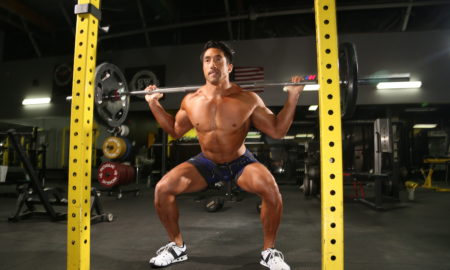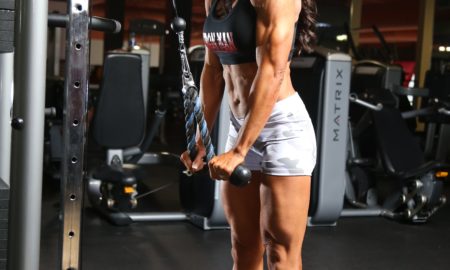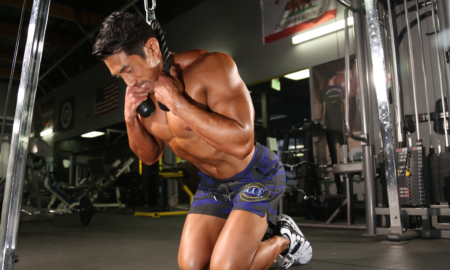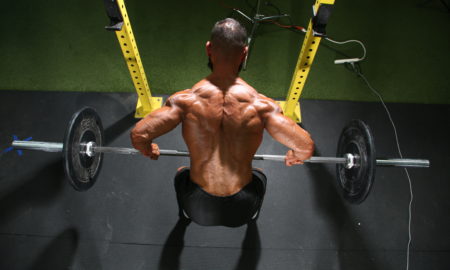The squat has received much praise and much criticism over the past 50 years. Leaders in the iron game, including Peary Rader, Bob Hoffman, Joe Weider, Joe Gold, John Balik, Steve Holman, countless Olympic weightlifting coaches and champions and champion bodybuilders have recommended squats in the the quest for strength, power and size.
There was a period in the 1960s when many doctors said that squats would ruin knees. Regrettably, that opinion was given a great deal of credibility but simply reflected the personal bias of doctors who’d never weight-trained. Today—fortunately—many in health care and sports sciences aren’t willing to accept mere opinions. We’re in a prove-it era.
Sean Flanagan, Ph.D., ATC, a biomechanics professor at California State University, Northridge, recently lectured on patellofemoral biomechanics—movement of the kneecap, or patella. He covered two key areas. The one I will address in this installment is the thinking that squats place stress on the kneecap.
Dr. Flanagan addressed a common topic of debate: Are full squats or half squats the best choice for the kneecap? Gym folklore has it that half squats are easier on the kneecap. Most Olympic weightlifters have very little pain under their kneecaps. If they have knee pain, it may be tendinitis from the many hours each week spent in hard training. We see the same thing with the shoulder from bench press enthusiasts.
Dr. Flanagan cited an article by Chris Powers, Ph.D., P.T., published in the Journal of Orthopaedic and Sports Physical Therapy in 1998. Dr. Powers noted that as the squat is performed, the trainee bends the knee, which distributes the forces from the squat across a broader surface area of the patella as it contacts the femur, or thigh bone. A shallow squat has less contact with the patella’s surface area, increasing the force on a small area. So the deeper squat has greater contact area on the patella than a shallow squat.
Another point that I have addressed in this column is the depth of the cartilage on the back of the kneecap. It is not uniform in thickness. It is thinner at the top and bottom and thicker in the middle. The thickest point lines up against the femur at the maximum stress on the patella during a squat. Maximum force of the squat on the patella lines up with the thickest cartilage to disperse the force.
If we flip the concept and look at the leg extension, we find that leg extension puts the maximum stress on the patella at full knee extension. Full knee extension on a leg extension machine places the most stress on the thinnest portion of the cartilage.
Trainees can have kneecap pain for other reasons. Not all kneecaps are the same shape. The groove in the thigh bone is not always the same depth. Some trainees have had knee injuries from other sports, including wear and tear of the cartilage, abnormal movement of the patella and dislocations of the patella. Such factors also come into play in the decision about how a trainee should perform squats. (Actually, the hip can have a much bigger impact on squatting, but that’s a topic for another column.)
If you’d like to try a full squat, lighten the weight initially, and learn proper technique. Give yourself time to become acclimated to the new squatting technique. Suppose you’d always performed bench presses only halfway down. Would you suddenly lower the same weight all the way to your chest? Of course not. You’d use less weight. The same applies to the squat.
Science and the gym do intersect, despite what some trainees think. Let’s use the best of both worlds to help you to have less pain and get better results.
Editor’s note: Visit www.SoftTissueCenter.com for reprints of Horrigan’s past Sportsmedicine columns that have appeared in IRON MAN. You can order the books, Strength, Conditioning and Injury Prevention for Hockey by Joseph Horrigan, D.C., and E.J. “Doc” Kreis, D.A., and the 7-Minute Rotator Cuff Solution by Horrigan and Jerry Robinson from Home Gym Warehouse, (800) 447-0008 or at www.Home-Gym.com.




















You must be logged in to post a comment Login